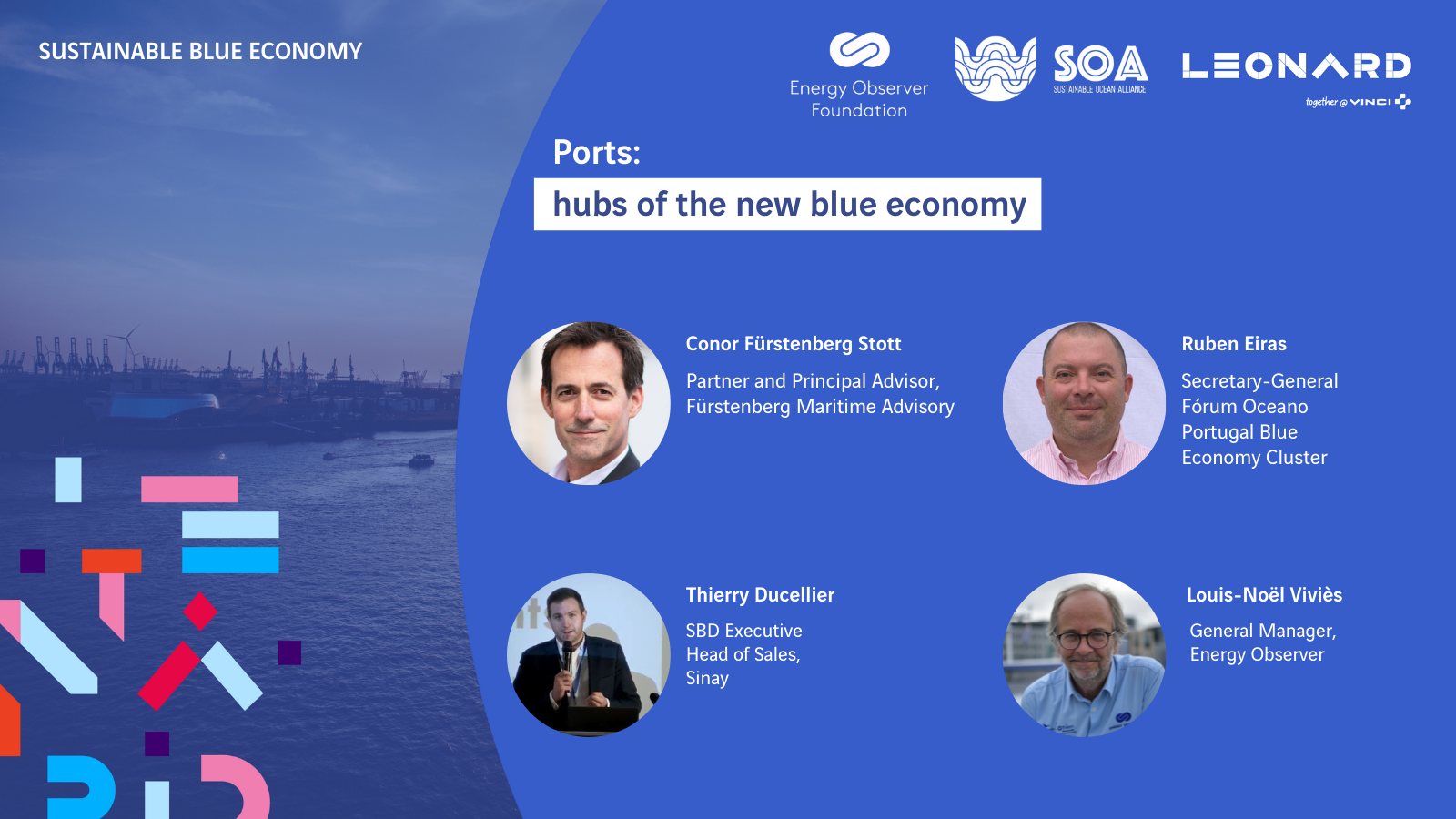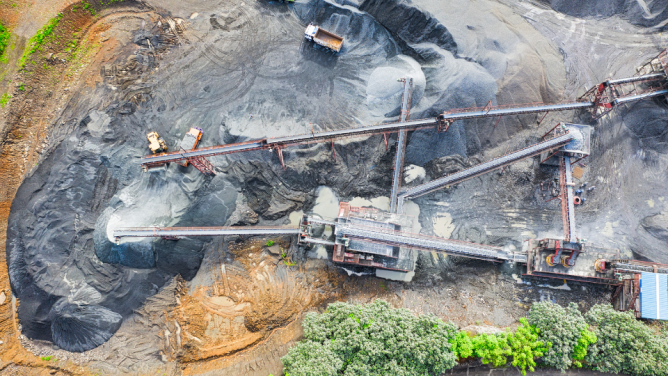
Three experts participated in this roundtable discussion moderated by Conor Fürstenberg Stott, Partner and Principal Advisor at Fürstenberg Maritime Advisory: Ruben Eiras, Secretary-General of Fórum Oceano, Portugal’s Blue Economy Cluster; Thierry Ducellier, SBD executive Head of Sales at Sinay; and Louis-Noël Viviès, General Manager at Energy Observer.
The gateways to a sustainable blue economy
Ports are complex interfaces that involve a variety of stakeholders, from municipalities and shipping contractors to offshore windfarms… to the extent that it seems almost impossible to list all the roles involved in a port’s life, notes Thierry Ducellier, head of sales at Sinay, a French startup offering maritime data solutions. Even our individual behavior, as demanding customers expecting their online orders to be delivered in 24 hours, has direct consequences on the operation and environmental impact of ports, says Ducellier. For Ruben Eiras, Secretary-General of Fórum Oceano, a large Portuguese cluster of blue economy companies, the responsibility of ports extends well beyond reducing their own footprint: they should instead strive to become hubs of the blue economy by focusing on their specificities. Large industrial ports and small fishing ports are not direct competitors and can increase their competitivity by capitalizing on their geographic and historic specificities. Certain industrial ports may be especially appropriate to the support of the floating offshore wind industry, says Eiras; while fishing ports, thanks to the absence of nearby industrial activities and the cleanness of their waters, may be appropriate sites for the development of onshore aquaculture facilities.
Ports’ geographical, economic, and historical specificities are at the heart of the Atlantic Smart Ports Blue Acceleration Network (ASPBEN), a project financed by the European Maritime and Fisheries Fund and comprised of 15 entities from Portugal, Spain, France, Netherlands, Norway, and the United States. Its aim: to build an accelerator platform for the blue economy built on a network of mid-sized ports. ASPBEN has identified ten challenges based on the needs expressed by 33 ports situated along the Atlantic, from increasing operational efficiency to promoting marine energy or using port infrastructure to foster biodiversity. All in all, over 140 pilots are to be implemented by 70 startups selected from a pool of 200, supporting the idea that all ports have a unique culture, and that building trust and collaboration among ports is a steppingstone to successful innovation.
The challenges ahead: from clean energy to digitalization
Decarbonization is key to the advent of a sustainable blue economy. For Louis-Noel Viviès, the decarbonization of maritime transportation will hang on the development of affordable, green hydrogen, a transition in which large ports have a crucial part to play. Viviès mentions Singapore, a top bunking port home to one of the world’s largest oil refineries. At the crossroads of countless maritime roads, the city-state could easily play a leading role by diverting 10% of the hydrogen it currently uses to produce diesel towards using hydrogen as a direct source of clean energy, says Viviès. Large ports, which are often primarily industrial sites, are in fact uniquely positioned to invest in clean energy sources.
The transition to a blue economy also depends on digitalization, a promising way for ports to increase their operational efficiency while slashing their greenhouse gas emissions. “Paradoxically, ports tend to be very conservative, while their success depends on being open and connected. Without access to certain routes, a port is done for. Ports must attract, and to do so, they must be interoperable and connected”, says Ruben Eiras. Yet a gap remains between theory and practice when it comes to digitalization. “Ports face many barriers: administrative complexity and politics often mean that testing solutions takes considerable time; by the time they are implemented, they are often obsolete”, says Thierry Ducellier.
And digital solutions are not enough: while highly efficient, port community systems, for instance, require well-trained staff and interoperability. These challenges mean that while many ports have the financials means to invest in their digitalization, many can still not go through with it. Another piece of the solution to increased digitalization may lie in better information-sharing: technology can help predict ships’ estimated arrival times, for instance, but “while the data is here, if it is not shared properly, it is not going to work”, says Thierry Ducellier.
By overcoming these challenges, ports can go from historic catalyzers of trade and development, says Ruben Eiras, to ultimate testbeds for the solutions that will transform energy, shipping, sustainable aquaculture, and ocean monitoring. The next decades will tell whether they can rise to the challenge and become pioneers of the blue economy.
Startup Pitches: ECOsubsea, Nature Metrics, Sinay
Our panel discussion was followed by pitches from three innovative companies working in the field of sustainable ports and maritime infrastructure.
ECOsubsea (Norway) offers an innovative solution to the challenge of biofouling, the detrimental accumulation of biodiversity on hulls and maritime infrastructure. Since a 2008 international ban on poisonous ingredients previously used to prevent this buildup, biofouling has become pervasive, leading species to “hitchhike” from one region to another, potentially causing considerable threats to local marine ecosystems and decreasing ships’ fuel efficiency. Faced with this challenge, ECOsubsea has designed a robot that behaves like a vacuum cleaner, thanks to a patented principle that cleans ships’ hulls without damaging their coating and uses the recovered biological material for biogas and green electricity production. Thanks to this groundbreaking solution, ECOsubsea recently removed 2 tons of biofouling from the hull of the Charles de Gaulle aircraft carrier and 78,500 tons from an oil rig in Norway. “We are strong believers in the idea that ports can play a vital role in decarbonizing shipping and stopping biodiversity collapse”, says ECOsubsea CEO and founder Tor Østervold.
In recent years, companies, ports, and organizations have become acutely aware of the need to monitor and mitigate their impact on marine biodiversity. Yet unlike carbon, biodiversity is not easily measured. That is why Nature Metrics (United Kingdom) has developed a marine biodiversity monitoring solution based on environmental DNA. “E-DNA is the biological footprint that an organism leaves behind in the water for a few hours to a few days after it has left the area. We use a water sample to generate a list of all the species that have been in the area within that timeframe”, says Samuel Stanton, Business Development Lead at Nature Metrics. The data is then presented in a highly engaging visualization that allows stakeholders to fully grasp the diversity of species in a given area. E-DNA allows for biodiversity comparisons between sites and provides a great way to measure the efficiency of biodiversity-restoration initiatives. While a conventional sample was unable to highlight the difference between a British oil refinery site and a neighboring nature reserve, E-DNA was able to show extreme differences in local biodiversity, creating clear data that speaks to stakeholders and allows for more informed decision-making.
Sinay (France) offers a data collaboration platform that helps the maritime industry better communicate and understand the impact of their activities on their environment. The company works to offer wind farms and port extensions the precise information needed to help them limit their environmental impact. Thanks to expert knowledge of the ocean, Sinay can recommend simple actions that can drastically reduce greenhouse gas (GHG) emissions: “without even talking about hydrogen or electrification, a mere two-knot decrease in a container ship’s speed can reduce its GHG emissions by thousands of tons”, says Thierry Ducellier, Sinay’s head of sales. Sinay’s cloud-based big data platform aggregates a wide variety of data to help ports monitor environmental metrics such as air or water quality in real-time and take appropriate measures when an issue arises. A necessary approach at a time when sustainability is bound to become synonymous with competitivity.
Watch the replay:
This event was the last in a cycle organized by Leonard in partnership with the Sustainable Ocean Alliance, which examined prospects for marine energy development, the future of ports and infrastructure, and the resilience of coasts and marine ecosystems. Check back later this month for our new report on the sustainable blue economy!

